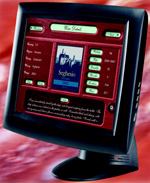These days high-end home buyers expect to have music in every room and a palette of viewing options at every TV. Internet in every room isn’t far behind, making cable and data outlets as much a part of the room planning as the AC wiring. As more and more people opt for structured wiring, there are more reasons to put it in. Now even the more esoteric upscale amenities in the luxury home are getting in on the networking act. First it was the refrigerator that could dial out to the e-grocer. Now the home piano and the wine cellar are plugging in and logging on.
If wiring the wine cellar for an Internet connection seems like overkill, consider the possibilities for the pampered homeowner. You’re planning a dinner for eight important guests and want the perfect robust red to go with filet mignon. Today you might look up a spreadsheet wine program on the PC, scratch down the rows where you’ve stored Cabernets, Bordeaux, or Barolos, and head down to the cellar with paper in hand.
In the home with the eSommelier wine management system, the computer lives in the wine cellar, which includes a touch-screen monitor that houses an all-in-one PC. You can search a 1,000-bottle wine collection in seconds by sorting through the collection by varietal, country, color, or year and get a list of all wines ready to drink now. For special guests, search for wines with the highest ratings from respected wine reviewers. The system comes bundled with some 140,000 wine listings from Wine Spectator magazine.
Add a $1,000 scanner to the $8,000 PC, and homeowners can scan in bottles when they bring home a case or two. When they check out a bottle from the library they can deduct the amount from the log to keep inventory accurate. When running low on a favorite bottle, they can place a note to order more. If shipping laws allow, they can punch a few keys and send an online order to a favorite wine merchant.
Users make selections from a menu-based interface using on-screen buttons that help guide the search. The interface follows the model of other home control functions for operating HVAC, lights, spa control, and entertainment. With its onboard RS-232 jack and support from AMX and Crestron, eSommelier can pop up as another control feature on home management touchscreens throughout the house. That way, homeowners can look up the location of the bottle they want using the kitchen touchscreen before heading down to the chilly cellar.
And because eSommelier packs Ethernet jacks, it can be wired into the home PC network. Users could even access the library over the Internet while traveling in Tuscany to see if there’s room for a few more cases of Sangiovese. Rack-mountable eSommelier units are available for integration with home control systems.
The Piano Plugs In Wire the cellar with in-wall speakers and homeowners will be able to listen to the upstairs piano while sipping port. Yamaha’s Mark IV Disklavier 21st-century player piano has gone the networking route too. A favorite of interior designers to decorate large entertainment spaces and of Liberace wannabes who never learned to play, Disklavier grand pianos have been popular in upscale homes both for their design appeal and entertainment value. A Disklavier can be played as a conventional acoustic grand piano or as a software-driven player piano.
In the latter mode, Disklavier pianos read specially formatted media that allows the piano to play by itself using digital data to control the keys. The latest version of the player extends the Disklavier into the multi-room realm. Now homeowners can send a digitized stream from the acoustic piano to other rooms in or outside of the house. The piano can also be wired to play as a conventional grand piano, while speakers in the room play backup orchestration.
The Mark IV Disklavier comes with a Wi-Fi remote control and a 10-inch touchscreen tablet PC. Both enable homeowners to operate the piano from other rooms—and through walls and ceilings. Users can select the piano as an audio source over a standard multi-room audio system and then use the remotes to change songs or create playlists from the 80-gigabyte hard drive built into the piano system.
The piano requires a standard 110-volt electrical outlet for power. Its analog and digital audio outputs run to the central music system, which sends the sound of the piano to other sound-ready rooms. The built-in Wi-Fi card allows the piano to communicate wirelessly with PCs on a home network, and an Ethernet port allows for connection to a more robust wired home network.



